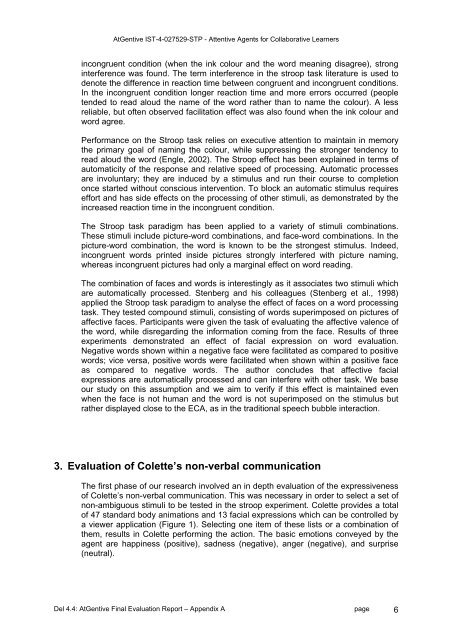Deliverable 4.4 - INSEAD CALT
Deliverable 4.4 - INSEAD CALT
Deliverable 4.4 - INSEAD CALT
Create successful ePaper yourself
Turn your PDF publications into a flip-book with our unique Google optimized e-Paper software.
AtGentive IST-4-027529-STP - Attentive Agents for Collaborative Learnersincongruent condition (when the ink colour and the word meaning disagree), stronginterference was found. The term interference in the stroop task literature is used todenote the difference in reaction time between congruent and incongruent conditions.In the incongruent condition longer reaction time and more errors occurred (peopletended to read aloud the name of the word rather than to name the colour). A lessreliable, but often observed facilitation effect was also found when the ink colour andword agree.Performance on the Stroop task relies on executive attention to maintain in memorythe primary goal of naming the colour, while suppressing the stronger tendency toread aloud the word (Engle, 2002). The Stroop effect has been explained in terms ofautomaticity of the response and relative speed of processing. Automatic processesare involuntary; they are induced by a stimulus and run their course to completiononce started without conscious intervention. To block an automatic stimulus requireseffort and has side effects on the processing of other stimuli, as demonstrated by theincreased reaction time in the incongruent condition.The Stroop task paradigm has been applied to a variety of stimuli combinations.These stimuli include picture-word combinations, and face-word combinations. In thepicture-word combination, the word is known to be the strongest stimulus. Indeed,incongruent words printed inside pictures strongly interfered with picture naming,whereas incongruent pictures had only a marginal effect on word reading.The combination of faces and words is interestingly as it associates two stimuli whichare automatically processed. Stenberg and his colleagues (Stenberg et al., 1998)applied the Stroop task paradigm to analyse the effect of faces on a word processingtask. They tested compound stimuli, consisting of words superimposed on pictures ofaffective faces. Participants were given the task of evaluating the affective valence ofthe word, while disregarding the information coming from the face. Results of threeexperiments demonstrated an effect of facial expression on word evaluation.Negative words shown within a negative face were facilitated as compared to positivewords; vice versa, positive words were facilitated when shown within a positive faceas compared to negative words. The author concludes that affective facialexpressions are automatically processed and can interfere with other task. We baseour study on this assumption and we aim to verify if this effect is maintained evenwhen the face is not human and the word is not superimposed on the stimulus butrather displayed close to the ECA, as in the traditional speech bubble interaction.3. Evaluation of Colette’s non-verbal communicationThe first phase of our research involved an in depth evaluation of the expressivenessof Colette’s non-verbal communication. This was necessary in order to select a set ofnon-ambiguous stimuli to be tested in the stroop experiment. Colette provides a totalof 47 standard body animations and 13 facial expressions which can be controlled bya viewer application (Figure 1). Selecting one item of these lists or a combination ofthem, results in Colette performing the action. The basic emotions conveyed by theagent are happiness (positive), sadness (negative), anger (negative), and surprise(neutral).Del <strong>4.4</strong>: AtGentive Final Evaluation Report – Appendix A page 6
















